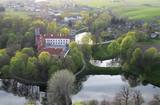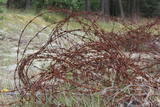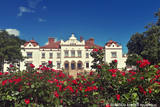| Nr | Nosaukums | Apraksts |
|---|---|---|
|
Jaukta plāna Ilzenberga muižas parks, izveidots 19.gs. otrajā pusē, ir palicis tāds pats līdz mūsdienām. Gleznaina, izteiksmīga reljefa vietā starp Ilgio un Apvalasa ezeriem. Atjaunojot parku, saglabāta bijušā parka telpiskā struktūra. Parks aizņem 10 ha teritoriju un ir veidots no divām daļām. Pirmā – tā ir salīdzinoši prezīca tainsstūra formas teritorija blakus muižai, apjozta ar mazlapu liepu rindām un ainaviski izvietotiem vietējo un introducēto koku sugu stādījumiem. Otrā daļā – dabiskā meža tipa stādījumi. Lielākais Ilzenberga muižas parkā augošais ozols ir pasludināts par valsts apskargājamo dabas mantojuma objektu. Šī varenā koka stumbra apkārtmērs – 6.3 m, diametrs – 2 m, augstums – 30,5 m. |
||
|
20. gs sākuma autentiska Latgales lauku sēta ar dzīvojamo māju, klēti, kūti, pirti, un smēdi. Te var noskatīties folkloras kopas priekšnesumus, svinēt Līgo svētkus un Miķeļdienas gadatirgu, apgūt amatu prasmes. Grupām piedāvā Latgales ēdienus. Latviešu virtuve: kļockas, pancaks ar cimusu, pašcepta maize, sviests, zāļu tējas un šmakovka. Īpašais ēdiens: Andrupenes maize. |
||
|
Atrodas Cēsu rietumdaļā – pie ceļa, kas ved uz Cīrulīšiem. Piedāvājumā – plašs ēdienu klāsts no brokastīm līdz vakariņām. |
||
|
Neliels pilskalns Mazā Soloja ezera ziemeļu krastā, kura nogāzē ir izveidotas kāpnes, bet virsotnē novietota Sv. Marijas statuja. |
||
|
Uzcelta 1610. gadā, vēlāk – pārbūvēta. Viena no Lietuvas izcilākajām renesanses laika būvēm. Viļņas Mākslas akadēmijas ekspozīcija. Skatu tornis. |
||
|
Skaisto un mūsdienās atjaunoto zilā krāsojuma ēku Karaīmu ielas 5 malā sākotnēji (1810. g.) cēla Dominikāņu mūki. Kopš 1864. g. tajā 23 gadus saimniekoja policija, līdz 1887. g. te izvietoja pastu un telegrāfu. Šobrīd ēkā atrodas nacionālā parka administrācija. |
||
|
Atrodas pilsētas centrā, Raiņa ielā 4. Dievnams celts (1932. – 1938. g.) vecās koka baznīcas vietā neogotikas stilā (J. Cīruļa projekts). Jāpiemin, ka līdz pat 1994. g. ēkā bija izvietojies kinofilmu iznomāšanas punkts. Tagad baznīcā apskatāma izstāde „No pamatiem līdz torņa smailei, senie Latgales būvamati fotoattēlos”, kur 108 fotoattēlos ir dokumentēts baznīcas celtniecības process. Interesenti var uzkāpt zvanu tornī un apskatīt Rēzekni no 37 m augstuma. |
||
|
Šī maršruta apkārtnē norisinājušies daudzi notikumi, kas tieši saistīti ar Latvijas valsts tapšanu un Brīvības cīņām. Vēsturisko ceļu no Rīgas uz Liepāju cauri Dobelei, Saldum, Skrundai, Durbei un Grobiņai var izsekot jau no seniem laikiem, pat sākot no 13. gadsimta. Kurzemē vienmēr ēduši jūras, upju un ezeru zivis, it īpaši kūpinātas. Novada ēdiens ir māla podiņā gatavota kūpināta menca ar piedevām. Sezonas gardums ir salakas un vēja zivis, bet brētliņas, siļķes un lasis pieejami visu gadu. Saimnieces cep rudzu ierauga rupjmaizi, saldskābmaizi un gardus sklandraušus, cienā ar miežu putraimu skābputru vai bukstiņputru. Nozīmīga loma ir piena produktiem, Jāņu sieram un “baltajam sviestam”. Svaigo govs piena sieru gatavo arī ar dillēm un ķiplokiem, tāpat gards ir kazas piena siers. Ēdienkartē netrūkst vietējo mājputnu un mājlopu gaļas ēdienu: cepeši, ribiņas, desiņas, var dabūt arī cūkas mēli un buļļa pautus. Smalkos krogos piedāvā fazānu un medījumus, papildinātus ar sēnēm un brūklenēm, kadiķogām un savvaļas garšaugiem. Kurzemē jūs sagaidīs ar gardiem pīrāgiem, plātsmaizēm, magoņmaizītēm un medus kūkām, cepumiem ar magonēm un dzērvenēm, saldēdienu no rudzu rīvmaizes, brūklenēm vai dzērvenēm un saldā krējuma. Iecienītas ir melleņu klimpas. Neparastāki ir gardumi no savvaļas augiem – marmelāde no pīlādžiem, dzērvenēm un pat skujām. Slāpes veldzēs smaržīgas zāļu tējas ar medu. Reibinoši mirkļi piedzīvojami pie alus kausa un mājas vīnu degustācijās. |
||
|
Latvijas lielākajā īpaši aizsargājamā dabas teritorijā (ap 6 % no valsts teritorijas), kas aptver daļu no Limbažu, Valmieras un Valkas rajoniem, sastopams ļoti daudzveidīgs un atšķirīgs ainavu, biotopu un sugu kopums. Salaca (ietilpst Salacas ielejas dabas parkā) ir viena no Baltijas jūras reģiona nozīmīgākajām lašu nārstu vietām. Upes ielejas ainava ar smilšakmens atsegumiem piesaista daudzus apmeklētājus – ne velti tā ir otra populārākā Vidzemes ūdenstūristu upe. Rīgas jūras līča austrumu piekraste salīdzinoši īsā krasta posmā izceļas ar lielu ainavu un biotopu atšķirību. Tās ziemeļos plešas piejūras Randu pļavas, vidusdaļā – smilšaini liedagi, bet dienviddaļā – akmeņaina krastmala divu desmitu kilometru garumā. Igaunijas pierobežā ir izvietojušies t.s. Ziemeļu purvi (ZBR dabas lieguma zona, NATURA 2000 teritorija "Ziemeļu purvi"), bet Sedas tīrelis ir viena no nozīmīgākajām putnu atpūtas un barošanās vietām migrāciju laikā. Rezervāta teritorija izceļas ar lielu mežu daudzveidību un tajā sastopami visi Latvijā esošie mežu tipi. Apmeklētājiem izveidotas interesantas dabas takas ar skatu torņiem vai platformām Randu pļavās, Burtnieka ezera krastā, Planču purvā, Niedrāju - Pilkas purvā, Dziļezera un Lielezera krastos u.c. Mazsalacas Skaņākalna parks ir viens no populārākajiem Ziemeļvidzemes tūrisma objektiem. Teritorijā atrodas arī daudzi nozīmīgi kultūras pieminekļi, t.sk. viena no pirmajām Latvijas apdzīvotām vietām, kur šodien atrodas t.s. Zvejnieku kapulauks (5. – 2. g.t. pr. Kr.). ZBR atrodas vēl divas dabas lieguma zonas - NATURA 2000 teritorijas "Vidusburtnieks" un "Augstroze".
|
||
|
Kafejnīca atrodas Tukuma centrā. Latviešu virtuve: Vārīta mēle, mēlīšu salāti, mājas rasols, mencu aknu salāti, zupas (frikadeļu, pupiņu, skābeņu), sautētas sēnes, mājas kotletes, plānās pankūkas, kraukšķīgās auzu pārslas, zemeņu zupa. |
||
|
Tahkunas bākaatrodas Hījumā ziemeļu tālākajā punktā. Francijā pasūtītā bāka izgatavota 1875. gadā. Tā ir arī augstākā Igaunijas piekrastes bāka, kas atrodas 42,7 m virs jūras līmeņa. |
||
|
Piektajā paaudzē (kopš 19. gs sākuma) – Latvijā vecākās mucinieku dzimtas tradīciju turpinātājs, kas darina ozola un oša mucas. Stāstījums, mucu vārīšanas, savilkšanas, stīpošanas un galdniecības darba procesa vērošana. Mucu un koka kubulu, pirts ķipīšu pasūtīšana un iegāde. |
||
|
Dabas liegums veidots eitrofā Istras ezera un tam pieguļošo biotopu – dažādu mežu tipu un pļavu aizsardzībai. Izcili ainaviska Latgales novada teritorija. Dabas liegumu var lieliski apskatīt, arī "no malas", braucot pa ceļiem, kas ieskauj Istras ezeru no ziemeļu un austrumu pusēm. Vietām atrodami labi ainaviski skatu punkti arī uz pārējiem apkārtnes ezeriem - Dziļezeru un Audzeļu ezeru, kas neietilpst lieguma teritorijā, kā arī Vecslabadu, kas atrodas ziemeļos no lieguma.
|
||
|
Raķešu bāze pretgaisa aizsardzībai izvietota plašā teritorijā dienvidos no Pāvilostas. Pamesta un degradēta dabas teritorija, kur izvietotas brīdinājuma zīmes "Bīstami, apdraud dzīvību".
|
||
|
Kafejnīca "Senda" atrodas Balvu centrā, Brīvības ielas (Viļakas virziens) malā. Piedāvā „mājas tipa” ēdienkarti, tādēļ iecienīta pusdienu ieturēšanas vieta. |
||
|
Rokišķu muzejs un muiža ir viens no svarīgākajiem Aukštaitijas kultūras centriem. Muižas ēkas diženumu izceļ parks un dīķi. |
||
|
Pirmā Mālpils pienotava savu darbību uzsāka jau 1923. gadā un tajā ražoja sviestu un sieru. Pagājušā gadsimta 70. gados šeit tika radīts Latvijā pirmais mīkstais nenogatavinātais siers – „Mālpils siers”. Iepriekš piesakot, var doties ekskursijā pa uzņēmumu ar produkcijas degustāciju. Sierus var iegādāties uz vietas - uzņēmuma noliktavā. |
||
|
Sv. Gara pareizticīgo baznīca un vīriešu klosteris, kā arī klostera teritorijā esošā Sv. Nikolaja Brīnumdarītāja pareizticīgo baznīca atrodas Jēkabpilī, Brīvības ielā 200. Bizantiešu stilā celtā Sv. Gara pareizticīgo baznīca tapusi laikā no 1853. - 1886. g. iepriekšējās - 17. gs. otrajā pusē celtās un 1773. g. nodegušā koka (kokmateriālus tās celtniecībai bija piešķīris Kurzemes hercogs Jēkabs) dievnama vietā. Pie baznīcas atradies Sv. Gara vīriešu klosteris. 1903. g. Otrajās Lieldienās baznīcā izcēlās ugunsgrēks, pēc kura nesadega vienīgi Jaunavas Marijas glezna. Baznīca cieta 1. pasaules kara laikā un to atkal atjaunoja 1933. g. Blakus Sv. Gara pareizticīgo baznīcai atrodas Jēkabpils vecākais dievnams - 1774. g. celtā mūra baznīca, kas nosaukta Sv. Nikolaja Brīnumdarītāja vārdā. Šī baznīca izceļas ar saviem nelielajiem izmēriem – 17 x 19,5 m. Mūsdienās te darbojas Sv. Gara pareizticīgo baznīcas klosteris, ko interesenti var apskatīt arī no iekšpuses. Kompleksu ietver iespaidīgs, Latvijas pilsētvidei neraksturīgs 17.gs. mūra žogs.
|
||
|
Daugavpils – Krāslavas (A 6) ceļa malā redzamais dievnams uzcelts ar Plāteru dzimtas pārstāvju – Vaclava un Kazimira Plātera atbalstu 1811. gadā. Dievnamu ieskauj metālkaluma un no ķieģeļiem mūrēts žogs, kā arī divi zvanu torņi. Labās puses zvanu tornī karājas vecs zvans. No baznīcas iekārtas ir jāpiemin galvenais altāris, ko rotā Dievmātes skulptūra, trīs biktskrēsli, četras evaņģēlistu sienas freskas un Lurdas Dievmātes glezna. Ikdienā apskatāma no ārpuses. |
||
|
Saimniecībā audzēto stādu (ābeles, bumbieres, ķirši, plūmes, upenes, jāņogas, ērkšķogas, avenes, krūmcidonijas, aronijas un saldie pīlādži) iegāde. Saimnieki dod padomus par augļu dārzu veidošanu un augļkoku audzēšanu. |
||



















